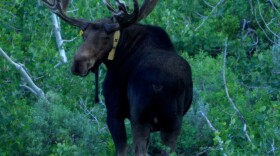In the early 1930s, teams of men scaled the rugged, mountainous walls of the Colorado River, suspended by rope, loosening rock with jackhammers and dynamite at the site of what was going to be the biggest infrastructure undertaking by the federal government thus far. Concrete was first poured June 6, 1933, and a massive man-made lake began to form in the canyon below. In September 1935, President Franklin D. Roosevelt dedicated Boulder Dam (now Hoover Dam) to a crowd of 20,000 in sweltering heat. A bit farther north, the little Mormon settlement town of St. Thomas would soon be hidden under 60 feet of water.
St. Thomas was first settled in 1865 by Thomas S. Smith and his party, and the town was abandoned by the LDS church in 1871. That’s pretty fast, and here’s why: In 1870, a survey placed the town in Nevada, instead of Utah or the Arizona territory. The Legislature then sent the settlers a demand for back pay on taxes … paid in gold coin. This was an agricultural community, so it caused hardship. The state ended up arresting some of them, according to a historical resources study of the area published in 1980. All but one of the settlers left.
Seven years later, some returned, and St. Thomas grew to about 2,000 people, some of whom are the namesake for nearby towns. Its last resident, Hugh Lord, paddled away on June 11, 1938, as Lake Mead’s water reached his doorstep, according to the National Park Service.
As is true with many Nevada settlements, white settlers were hardly the first ones there. In fact, there’s evidence of human activity in the area dating back to 8000 B.C. In nearby Overton’s Lost City Museum, you can learn more about the area of St. Thomas, home to Basketmaker People in 300 A.D. and later co-inhabited by the Pueblo. The historical record began when Jebediah Smith found artifacts there in 1827, and by 1924, two residents of Overton “stumbled on” the ruins of the “Lost City,” which became a tourist hot spot. Many artifacts are housed at the museum, including the Pueblo Grande de Nevada, the set of villages now listed on the National Register of Historic Places.
Fast forward a few decades after the dam, mix in an extreme, prolonged drought, and St. Thomas reappears. Today, the town’s exposed remains sit farther and farther from shore as the drought drags on, but you can still visit them via a short hike not far from where the Muddy and Virgin rivers meet.
This is near the undisclosed location that “Outdoor Nevada” host Connor Fields visited with Corey Lange, a Bureau of Land Management biologist, to see the relic leopard frog, previously thought to be extinct. They visited a spring complex where a safe harbor population (managed by wildlife officials and kept secret) of the endangered amphibian dwells. The natural range of the frog includes St. Thomas, but the springs and seeps have been heavily modified over time.
“You would never guess there would be a frog habitat in this location,” Lange told Fields. “Being here and seeing the work that’s happening is fascinating. The area has multiple springs, which have been diverted and dammed to create several habitats to support the relic leopard frog and the other local inhabitants.”
The much more public two-mile trail to St. Thomas is quite flat and easy. A lack of shade and its location in the hot desert mean you should plan to visit in cooler months.
What: See the ruins of St. Thomas
Getting there: From Las Vegas, take I-15 N for about 34 miles until you reach Exit 75 for Valley of Fire Hwy. Merge onto that road and continue for 23 more miles. Turn right onto Northshore Rd. (in Lake Mead National Recreation Area), then left on Old Saint Thomas Road.
Equipment needed: A vehicle that can handle bumpy dirt roads, a map or GPS device, and the usual things needed for hiking in the desert (sturdy shoes, hat, sunscreen, plenty of water).
Pro tip: If you’re feeling adventurous, continue south in the park to Old Swim Beach, and hike down (with ample water) to the confluence of the Muddy River and Virgin River. Be careful if you see any frogs.









